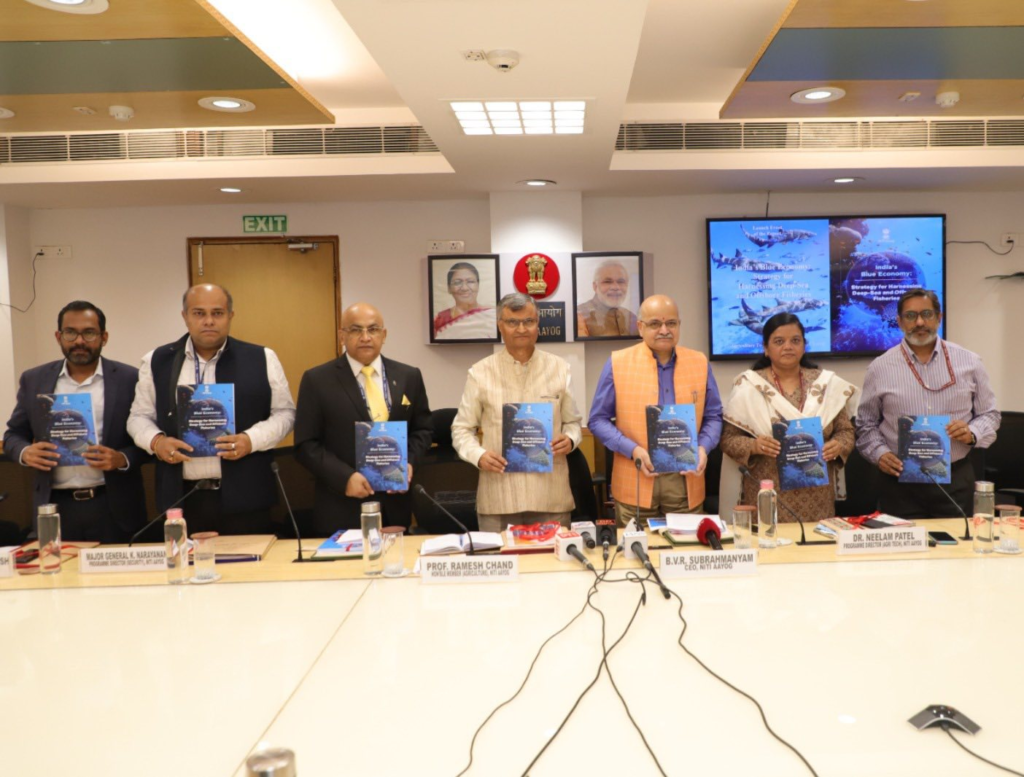UPSC Relevance –
GS Paper II (Governance, Policies, and International Relations):
GS Paper III (Economic Development, Environment, and Security)
Why in News
NITI Aayog has released a report titled “India’s Blue Economy – Strategy for Harnessing Deep-Sea and Offshore Fisheries”. The report outlines a scientific, sustainable, and inclusive roadmap for developing India’s deep-sea and offshore fishing sector, aiming to boost exports, create livelihoods, and strengthen India’s maritime presence.

Background: Understanding India’s Blue Economy
The Blue Economy refers to the sustainable use of ocean resources to drive economic growth, support livelihoods, and protect marine ecosystems. It covers sectors like fisheries, tourism, shipping, and renewable energy, while addressing challenges such as climate change and marine pollution.
In the Interim Budget 2024, the government introduced Blue Economy 2.0, emphasizing:
- Restoration of coastal ecosystems
- Sustainable aquaculture
- A multi-sectoral approach for ocean development
Oceans cover 75% of the Earth’s surface and contribute significantly to global GDP, making the Blue Economy essential for sustainable development. Key initiatives include:
- Sagarmala Project – port-led infrastructure and coastal development
- Deep Ocean Mission – exploration and sustainable use of deep-sea resources
- International collaborations – like the India-Norway Task Force on Blue Economy
These efforts provide the foundation for expanding India’s offshore and deep-sea fisheries while balancing economic growth with ecological sustainability.
Current Status of Deep-Sea Fishing in India
- Underdeveloped Sector: India has a big potential for deep-sea fishing—about 7.16 million tonnes in its ocean areas—but most of it is still not being used.
- Limited International Presence: India has only 4 fishing vessels operating in international waters, while countries like Sri Lanka have 1,883 and Iran has 1,216. This shows India is far behind in global deep-sea fishing.
- Regulatory Gaps: There is no specific law to control fishing beyond 12 nautical miles from the coast. This leads to illegal, unreported, and unregulated (IUU) fishing.
- State Limitations: Indian states can only manage fishing up to 12 nautical miles. This limits their ability to monitor or control fishing in deeper waters farther out at sea.
Opportunities and Potential of Deep-Sea Fishing in India:
- Economic Growth: Expanding deep-sea fishing can significantly boost India’s economy. Exports from fisheries reached ₹60,523 crore in FY 2023–24, and tapping deep-sea resources can further increase this.
- Livelihood Creation: Modern deep-sea vessels can earn about ₹32 lakh per year, nearly 10 times more than earnings from small coastal boats. This can create high-income jobs for fishermen and related industries.
- Relieving Coastal Pressure: Shifting fishing activities to deeper waters helps reduce overfishing in coastal areas, allowing inshore fish stocks to recover and promoting sustainable fishing practices.
- Untapped Resources: India’s deep-sea species, like lanternfish, squid, and shrimp, have a potential of 1.847 million tonnes, most of which remain underutilized. Proper exploitation can increase food and export supply.
- Strategic Advantage: A strong offshore fishing fleet not only improves food security but also strengthens India’s maritime presence in the Indian Ocean, giving a strategic edge in the region.
Major Challenges in Deep-Sea Fishing in India:
- Policy Gaps: India does not have a single law to manage fishing in its entire Exclusive Economic Zone (EEZ). Coordination between maritime, environmental, and defense authorities is weak.
- Infrastructure Deficit: Out of 90 fishing harbors, very few can handle large deep-sea vessels. Lack of cold storage and processing units also limits export potential.
- High Costs: Deep-sea fishing requires expensive fuel, equipment, and maintenance, making it difficult for small-scale fishers to participate.
- Data Deficiency: There is no central database for fish stocks or species mapping. This leads to poor planning and risks of overfishing.
- Environmental Risks: Practices like bottom trawling, bycatch, and marine pollution can damage fragile deep-sea ecosystems, threatening sustainability.
Global Best Practices
- China: Operates large distant-water fleets with support “motherships,” allowing fishing far from the coast. This helps achieve high production and export capacity but carries risks of overfishing and environmental degradation.
- Spain: Implements Vessel Monitoring Systems (VMS) to track boats, adopts eco-friendly gear, and ensures catch traceability. Spain also focuses on sustainable fisheries management, balancing economic benefits with conservation.
- New Zealand: Uses a Quota Management System (QMS), where fishers receive allocated catch rights. This ensures sustainable harvests, prevents overexploitation, and maintains ecological balance.
- Norway: Focuses on scientific stock assessment and implements strict catch limits. Norway also encourages certified sustainable seafood, improving market access globally.
- Iceland: Combines co-management with local communities, giving fishers a stake in resource conservation. They use real-time monitoring and promote marine ecosystem protection alongside economic growth.
Key Recommendations by NITI Aayog on Deep-Sea Fishing:
- Policy Overhaul:
- Draft a national EEZ Fisheries Act in line with UNCLOS to regulate fishing beyond 12 nautical miles.
- Revise subsidies to reward sustainable fishing practices rather than just fuel or equipment support.
- Institutional Strengthening:
- Establish a Deep-Sea Fisheries Authority to coordinate policy, research, and monitoring.
- Invest in research, data collection systems, and develop skilled manpower for deep-sea operations.
- Fleet Modernisation:
- Promote vessels equipped with GPS and cold-storage facilities for efficient and sustainable fishing.
- Encourage cooperative ownership models so that small fishers can participate and benefit collectively.
- Sustainable Management:
- Adopt ecosystem-based catch limits to prevent overfishing and conserve marine life.
- Enforce marine spatial planning and real-time vessel tracking to monitor fishing activities effectively.
- Financing Mechanism:
- Create a Deep-Sea Fishing Development Fund with public-private partnerships (PPP), soft loans, and insurance support for fishers.
- Stakeholder Inclusion:
- Empower fishing communities in decision-making and governance.
- Include small-scale fishers in capacity-building programs and ensure they receive economic benefits.
Conclusion
The report envisions a Blue Revolution 2.0, combining economic growth with ecological sustainability. A regulated and modern deep-sea sector can:
- Boost exports
- Secure livelihoods
- Strengthen India’s maritime presence
This aligns with India’s goal of a sustainable and prosperous Blue Economy, ensuring that the oceans contribute effectively to the nation’s growth, food security, and global standing.
UPSC Mains-practice question
Q-“Despite having one of the largest Exclusive Economic Zones (EEZ) in the world, India’s deep-sea fishing sector remains largely underdeveloped. In light of this, discuss the opportunities, challenges, and policy measures needed to promote sustainable deep-sea fishing in India. Illustrate your answer with global best practices.”(150 words)
